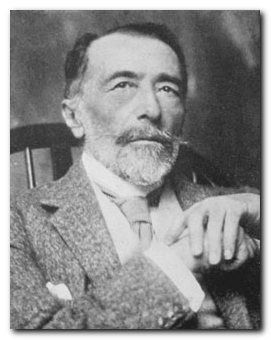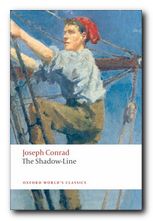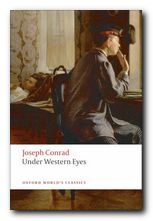tutorial, commentary, study resources, and web links
The Shadow Line: A Confession (1917) is one of a number of Conrad’s works which draw upon his own experiences as a seaman during his third visit to the far East in 1887-1888. He signed up as mate on the Vidar, which traded in the islands of Malaysia, but just like the young man in this story he signed off and was then given his first (and only) command of his own ship. He travelled from Singapore to Bangkok to take over as captain of the Otago, then took the ship to Sydney, calling in en route at Singapore to pick up medical supplies.

Joseph Conrad
The fact that these elements are reflected in the story should not lead readers to suppose that the finished work is merely a biographical record. The relationship between biography and fiction is a complex issue, and it should be remembered that not only do writers transform personal experience to give it artistic shape and force, but there is no direct and simple relationship between a personal experience and its depiction in fictional form.
The Shadow Line – critical commentary
Narrative structure
The main elements of the narrative are arranged in a very simple pattern. The story begins in Singapore as the young captain secures his first command. He travels to Bangkok to join his ship, and sails back to where he came from, in Singapore. This structure echoes the main thematic development of the novella – his change from a state of youth and immaturity to that of an older and wiser man who has been hardened by the grim experiences of his journey.
Conrad is renowned for the complexity of his novels and stories – particularly the radically fractured time schemes of his narratives. But the structure and the sequence of events in The Shadow-Line are relatively straightforward. Events are related by a single first-person narrator, the young sea captain, and he delivers them in the same sequence that they occur, with no flashes forward or backward.
The only element of ‘back story’ is provided by the chief mate’s account of his conflict with the previous captain, and the only part of the text which is not either dialogue or first person narrative is two brief extracts from the young captain’s diary. In fact it’s difficult to understand why Conrad bothered including these two short passages, because they continue to recount events in the same sequence and in a similar manner.
Steam and Sail
At the start of the tale, the young sailor’s position as mate on the steam ship is comfortable and he is successful in it – carrying the approval of his captain (Kent). Yet he leaves the ship, for reasons he cannot explain. The experienced seamen with whom he discusses the issue put it down to his youthful impetuosity.
Yet when he takes up his command of the sailing ship he is in raptures with the ship itself which he thinks of as ‘she’ and himself as a lover. He also conceives of himself as the latest in a long honourable tradition of previous captains. (This is powerfully ironic in the light of the previous captain and his actions.)
But there are immediate problems connected with the type of vessel. The sailing ship requires a great number of men on deck, co-operating with each other to manage the sails and navigation. These are exactly what the captain does not have, because the crew are down with malaria. He is therefore forced to manage the ship himself, assisted by two crew who are both ill.
In the end he succeeds – so in one sense it is the older traditions of the sea and the earlier form of maritime technology which provide him with the gruelling experience that forms his character. He learns the value of co-operative working methods.
Youth and experience
At the start of the narrative, the young seaman is competent, but he displays the impetuosity and naivety of youth. He gives up his job without any good reason, and has no alternative career prospects. He fails to recognise that Captain Giles has recommended him to the Harbour Master, and his mood switches rapidly from despair to elation on learning of his new appointment. He also disregards the medical advice he is given, and sets sail without the services of a chief mate.
In his favour is the fact that his essential soundness is recognised by Captain Kent, his previous commander, the experienced Captain Giles, and the Harbour Master who gives him his position. He survives under the pressure of the ship’s misfortunes, and he has the good luck not to contract malaria like the rest of his crew.
Once back in Singapore, he realises that he has learned a severe lesson, he feels older (though only two or three weeks have passed) and at the end of the story he is intending to start out to complete his journey the very next day.
Novel, novella, story?
The narrative is one hundred pages – approximately 30,000 words – which means it could be considered a short novel or a long short story. But it has the classic characteristics of the novella. It is concerned essentially with a single experience in the life of one character, but the event it deals with is of a magnitude that makes it more than a passing episode. That is, it deals with a universal issue, not a particular event (no matter how revealing).
The captain’s experiences test his courage to the limit; he learns a very severe lesson; and he ultimately triumphs against adversity in a way which takes him from youth to manhood. These are large-scale issues, much bigger than the smaller (though revealing) incidents which would characterize the short story.
All the drama is concentrated into one topic and one location – the captain’s command and his problems on board the ship. Even his interactions with others are reduced essentially to just the saintly cook and the deranged chief mate. This sharpness of dramatic focus reinforces the especially compacted nature of the novella as a literary genre.
The title
Readers might be forgiven for thinking that the title refers to a shipping company – but Conrad uses the term ‘shadow-line’ two or three times throught the novella in a mataphoric sense.
time, too, goes on – till one perceives ahead a shadow-line warning one that the region of early youth, too, must be left behind
The line is therefore a zone of transition between two states of being – youthfulness and maturity – which is the pricipal issue of the novella as a whole. When the young captain’s morale is at its lowest point he communes with himself in a diary, reflecting on the difference between his current despair and the youthful enthusiasm with which he began his voyage fifteen days earlier:
It seems to me that all my life before that momentous day is infinitely remote, a fading memory of light-hearted youth, something on the other side of a shadow
The Shadow Line – study resources
![]() The Shadow-Line – Oxford World Classics – Amazon UK
The Shadow-Line – Oxford World Classics – Amazon UK
![]() The Shadow-Line – Oxford World Classics – Amazon US
The Shadow-Line – Oxford World Classics – Amazon US
![]() The Shadow-Line – Kindle eBook (annotated)
The Shadow-Line – Kindle eBook (annotated)
![]() The Shadow-Line – Penguin Classics – Amazon UK
The Shadow-Line – Penguin Classics – Amazon UK
![]() The Shadow-Line – Penguin Classics – Amazon US
The Shadow-Line – Penguin Classics – Amazon US
![]() The Shadow-Line – Wordsworth Classics – Amazon UK
The Shadow-Line – Wordsworth Classics – Amazon UK
![]() The Shadow-Line – Wordsworth Classics – Amazon US
The Shadow-Line – Wordsworth Classics – Amazon US
![]() The Shadow Line – eBook versions at Project Gutenberg
The Shadow Line – eBook versions at Project Gutenberg
![]() Joseph Conrad: A Biography – Amazon UK
Joseph Conrad: A Biography – Amazon UK
![]() The Cambridge Companion to Joseph Conrad – Amazon UK
The Cambridge Companion to Joseph Conrad – Amazon UK
![]() Routledge Guide to Joseph Conrad – Amazon UK
Routledge Guide to Joseph Conrad – Amazon UK
![]() Oxford Reader’s Companion to Conrad – Amazon UK
Oxford Reader’s Companion to Conrad – Amazon UK
![]() Notes on Life and Letters – Amazon UK
Notes on Life and Letters – Amazon UK
![]() Joseph Conrad – biographical notes
Joseph Conrad – biographical notes
The Shadow-Line – plot summary
A young, inexperienced, but competent seaman suddenly gives up his successful position as mate on a steamship. Whilst he is on shore in Singapore an older and experienced sea captain recommends him to the harbour master, as a result of which he is given command of a sailing ship whose captain has died at sea. He travels to Bangkok to take charge of the ship and feels that he is joining an illustrious brotherhood of distinguished former commanders. However, he learns from the chief mate that the previous captain was dissolute and neglected his duties, The chief mate was forced to take charge of the ship, and the captain cursed the ship and all its crew before dying.
 The new young captain is delayed in Bangkok by a combination of official procedures and the chief mate’s illness. He seeks medical advice, but impatient to be underway with his new commission, he disregards the warnings and sets sail in unfavourable conditions. The journey progresses very slowly because of a lack of wind, and the ship becomes becalmed in the Gulf of Siam. Meanwhile all the crew are infected with malaria, and the chief mate appears to be dying. The mate believes that an evil influence from the previous captain is casting a jinx on the ship.
The new young captain is delayed in Bangkok by a combination of official procedures and the chief mate’s illness. He seeks medical advice, but impatient to be underway with his new commission, he disregards the warnings and sets sail in unfavourable conditions. The journey progresses very slowly because of a lack of wind, and the ship becomes becalmed in the Gulf of Siam. Meanwhile all the crew are infected with malaria, and the chief mate appears to be dying. The mate believes that an evil influence from the previous captain is casting a jinx on the ship.
The young captain then suddenly discovers that the supplies of quinine he has been using to treat his crew have been stolen and sold by the previous captain, who has re-filled the bottles with useless stuff. The captain is supported in all his attempts to keep going by the ship’s cook, who has a bad heart.
The chief mate recovers slightly, but the ship makes no progress. The captain in despair decides to abandon the voyage and return to Singapore. En route the ship encounters a tropical thunderstorm, and the captain has to maintain the safety of the ship with the help of only two or three sick crew members. The chief mate goes through a phase of near madness in which he believes that they are battling against evil forces of the former captain, who he personally buried at sea in the same part of the Gulf.
Finally, the ship reaches Singapore, the crew are taken off to hospital, and the cook requests to be discharged from his duties. The captain recruits a replacement crew and is planning to resume his voyage the very next day, feeling older and wiser.
Biography
Principal characters
| I | the narrator, an unnamed young mariner |
| Hamilton | a non-paying loafer and snob |
| Captain Giles | an experienced retired navigator |
| Chief Steward | custodian of the Officers’ Sailors’ Home |
| Captain Kent | commander of the narrator’s previous ship |
| Captain Ellis | harbour master in Singapore |
| R | gay shipping master in harbour office |
| Burns | chief mate |
| Doctor | medical chief in Bangkok |
| Ransome | the cook with a bad heart |
| Gambril | a grizzled sailor |
| Frenchy | sailor with a Mr Punch face |
The Shadow Line – publication

first edition, J.M.Dent 1917
 The Cambridge Companion to Joseph Conrad offers a series of essays by leading Conrad scholars aimed at both students and the general reader. There’s a chronology and overview of Conrad’s life, then chapters that explore significant issues in his major writings, and deal in depth with individual works. These are followed by discussions of the special nature of Conrad’s narrative techniques, his complex relationships with late-Victorian imperialism and with literary Modernism, and his influence on other writers and artists. Each essay provides guidance to further reading, and a concluding chapter surveys the body of Conrad criticism.
The Cambridge Companion to Joseph Conrad offers a series of essays by leading Conrad scholars aimed at both students and the general reader. There’s a chronology and overview of Conrad’s life, then chapters that explore significant issues in his major writings, and deal in depth with individual works. These are followed by discussions of the special nature of Conrad’s narrative techniques, his complex relationships with late-Victorian imperialism and with literary Modernism, and his influence on other writers and artists. Each essay provides guidance to further reading, and a concluding chapter surveys the body of Conrad criticism.
Critical studies
![]() Ted Billy, A Wilderness of Words: Closure and Disclosure in Conrad’s Short Fiction, Lubbock: Texas Tech University Press, 1997.
Ted Billy, A Wilderness of Words: Closure and Disclosure in Conrad’s Short Fiction, Lubbock: Texas Tech University Press, 1997.
![]() Gary Geddes, Conrad’s Later Novels, Montreal: McGill-Queen’s University Press, 1980.
Gary Geddes, Conrad’s Later Novels, Montreal: McGill-Queen’s University Press, 1980.
![]() Stephen K. Land, Conrad and the Paradox of Plot, London: Macmillan Press, 1984.
Stephen K. Land, Conrad and the Paradox of Plot, London: Macmillan Press, 1984.
![]() F.R.Leavis, ‘The Shadow-Line’, in Anna Karenina and Other Essays, London: Chatto and Windus, 1967.
F.R.Leavis, ‘The Shadow-Line’, in Anna Karenina and Other Essays, London: Chatto and Windus, 1967.

Joseph Conrad’s writing table
Further reading
![]() Amar Acheraiou Joseph Conrad and the Reader, London: Macmillan, 2009.
Amar Acheraiou Joseph Conrad and the Reader, London: Macmillan, 2009.
![]() Jacques Berthoud, Joseph Conrad: The Major Phase, Cambridge: Cambridge University Press, 1978.
Jacques Berthoud, Joseph Conrad: The Major Phase, Cambridge: Cambridge University Press, 1978.
![]() Muriel Bradbrook, Joseph Conrad: Poland’s English Genius, Cambridge: Cambridge University Press, 1941
Muriel Bradbrook, Joseph Conrad: Poland’s English Genius, Cambridge: Cambridge University Press, 1941
![]() Harold Bloom (ed), Joseph Conrad (Bloom’s Modern Critical Views, New Yoprk: Chelsea House Publishers, 2010
Harold Bloom (ed), Joseph Conrad (Bloom’s Modern Critical Views, New Yoprk: Chelsea House Publishers, 2010
![]() Hillel M. Daleski , Joseph Conrad: The Way of Dispossession, London: Faber, 1977
Hillel M. Daleski , Joseph Conrad: The Way of Dispossession, London: Faber, 1977
![]() Daphna Erdinast-Vulcan, Joseph Conrad and the Modern Temper, Oxford: Oxford University Press, 1991.
Daphna Erdinast-Vulcan, Joseph Conrad and the Modern Temper, Oxford: Oxford University Press, 1991.
![]() Aaron Fogel, Coercion to Speak: Conrad’s Poetics of Dialogue, Cambridge, Mass: Harvard University Press, 1985
Aaron Fogel, Coercion to Speak: Conrad’s Poetics of Dialogue, Cambridge, Mass: Harvard University Press, 1985
![]() John Dozier Gordon, Joseph Conrad: The Making of a Novelist, Cambridge, Mass: Harvard University Press, 1940
John Dozier Gordon, Joseph Conrad: The Making of a Novelist, Cambridge, Mass: Harvard University Press, 1940
![]() Albert J. Guerard, Conrad the Novelist, Cambridge, Mass: Harvard University Press, 1958
Albert J. Guerard, Conrad the Novelist, Cambridge, Mass: Harvard University Press, 1958
![]() Robert Hampson, Joseph Conrad: Betrayal and Identity, Basingstoke: Macmillan, 1992
Robert Hampson, Joseph Conrad: Betrayal and Identity, Basingstoke: Macmillan, 1992
![]() Jeremy Hawthorn, Joseph Conrad: Language and Fictional Self-Consciousness, London: Edward Arnold, 1979
Jeremy Hawthorn, Joseph Conrad: Language and Fictional Self-Consciousness, London: Edward Arnold, 1979
![]() Jeremy Hawthorn, Joseph Conrad: Narrative Technique and Ideological Commitment, London: Edward Arnold, 1990
Jeremy Hawthorn, Joseph Conrad: Narrative Technique and Ideological Commitment, London: Edward Arnold, 1990
![]() Jeremy Hawthorn, Sexuality and the Erotic in the Fiction of Joseph Conrad, London: Continuum, 2007.
Jeremy Hawthorn, Sexuality and the Erotic in the Fiction of Joseph Conrad, London: Continuum, 2007.
![]() Owen Knowles, The Oxford Reader’s Companion to Conrad, Oxford: Oxford University Press, 1990
Owen Knowles, The Oxford Reader’s Companion to Conrad, Oxford: Oxford University Press, 1990
![]() Jakob Lothe, Joseph Conrad: Voice, Sequence, History, Genre, Ohio State University Press, 2008
Jakob Lothe, Joseph Conrad: Voice, Sequence, History, Genre, Ohio State University Press, 2008
![]() Gustav Morf, The Polish Shades and Ghosts of Joseph Conrad, New York: Astra, 1976
Gustav Morf, The Polish Shades and Ghosts of Joseph Conrad, New York: Astra, 1976
![]() Ross Murfin, Conrad Revisited: Essays for the Eighties, Tuscaloosa, Ala: University of Alabama Press, 1985
Ross Murfin, Conrad Revisited: Essays for the Eighties, Tuscaloosa, Ala: University of Alabama Press, 1985
![]() Jeffery Myers, Joseph Conrad: A Biography, Cooper Square Publishers, 2001.
Jeffery Myers, Joseph Conrad: A Biography, Cooper Square Publishers, 2001.
![]() Zdzislaw Najder, Joseph Conrad: A Life, Camden House, 2007.
Zdzislaw Najder, Joseph Conrad: A Life, Camden House, 2007.
![]() George A. Panichas, Joseph Conrad: His Moral Vision, Mercer University Press, 2005.
George A. Panichas, Joseph Conrad: His Moral Vision, Mercer University Press, 2005.
![]() John G. Peters, The Cambridge Introduction to Joseph Conrad, Cambridge: Cambridge University Press, 2006.
John G. Peters, The Cambridge Introduction to Joseph Conrad, Cambridge: Cambridge University Press, 2006.
![]() James Phelan, Joseph Conrad: Voice, Sequence, History, Genre, Ohio State University Press, 2008.
James Phelan, Joseph Conrad: Voice, Sequence, History, Genre, Ohio State University Press, 2008.
![]() Edward Said, Joseph Conrad and the Fiction of Autobiography, Cambridge Mass: Harvard University Press, 1966
Edward Said, Joseph Conrad and the Fiction of Autobiography, Cambridge Mass: Harvard University Press, 1966
![]() Allan H. Simmons, Joseph Conrad: (Critical Issues), London: Macmillan, 2006.
Allan H. Simmons, Joseph Conrad: (Critical Issues), London: Macmillan, 2006.
![]() J.H. Stape, The Cambridge Companion to Joseph Conrad, Cambridge: Cambridge University Press, 1996
J.H. Stape, The Cambridge Companion to Joseph Conrad, Cambridge: Cambridge University Press, 1996
![]() John Stape, The Several Lives of Joseph Conrad, Arrow Books, 2008.
John Stape, The Several Lives of Joseph Conrad, Arrow Books, 2008.
![]() Peter Villiers, Joseph Conrad: Master Mariner, Seafarer Books, 2006.
Peter Villiers, Joseph Conrad: Master Mariner, Seafarer Books, 2006.
![]() Ian Watt, Conrad in the Nineteenth Century, London: Chatto and Windus, 1980
Ian Watt, Conrad in the Nineteenth Century, London: Chatto and Windus, 1980
![]() Cedric Watts, Joseph Conrad: (Writers and their Work), London: Northcote House, 1994.
Cedric Watts, Joseph Conrad: (Writers and their Work), London: Northcote House, 1994.
Other novels by Joseph Conrad
 Under Western Eyes (1911) is the story of Razumov, a reluctant ‘revolutionary’. He is in fact a coward who is mistaken for a radical hero and cannot escape from the existential trap into which this puts him. This is Conrad’s searing critique of Russian ‘revolutionaries’ who put his own Polish family into exile and jeopardy. The ‘Western Eyes’ are those of an Englishman who reads and comments on Razumov’s journal – thereby creating another chance for Conrad to recount the events from a very complex perspective. Razumov achieves partial redemption as a result of his relationship with a good woman, but the ending, with faint echoes of Dostoyevski, is tragic for all concerned.
Under Western Eyes (1911) is the story of Razumov, a reluctant ‘revolutionary’. He is in fact a coward who is mistaken for a radical hero and cannot escape from the existential trap into which this puts him. This is Conrad’s searing critique of Russian ‘revolutionaries’ who put his own Polish family into exile and jeopardy. The ‘Western Eyes’ are those of an Englishman who reads and comments on Razumov’s journal – thereby creating another chance for Conrad to recount the events from a very complex perspective. Razumov achieves partial redemption as a result of his relationship with a good woman, but the ending, with faint echoes of Dostoyevski, is tragic for all concerned.
![]() Buy the book from Amazon UK
Buy the book from Amazon UK
![]() Buy the book from Amazon US
Buy the book from Amazon US
 Chance is the first of Conrad’s novels to achieve a wide commercial success, and one of the few to have a happy ending. It tells the story of Flora de Barral, the abandoned daughter of a bankrupt tycoon, and her long struggle to find happiness and dignity. He takes his techniques of weaving complex narratives to a challenging level here. His narrator Marlow is piecing together the story from a mixture of personal experience and conversations with other characters in the novel. At times it is difficult to remember who is saying what to whom. This is a work for advanced Conrad fans only. Make sure you have read some of the earlier works first, before tackling this one.
Chance is the first of Conrad’s novels to achieve a wide commercial success, and one of the few to have a happy ending. It tells the story of Flora de Barral, the abandoned daughter of a bankrupt tycoon, and her long struggle to find happiness and dignity. He takes his techniques of weaving complex narratives to a challenging level here. His narrator Marlow is piecing together the story from a mixture of personal experience and conversations with other characters in the novel. At times it is difficult to remember who is saying what to whom. This is a work for advanced Conrad fans only. Make sure you have read some of the earlier works first, before tackling this one.
![]() Buy the book from Amazon UK
Buy the book from Amazon UK
![]() Buy the book from Amazon US
Buy the book from Amazon US
Joseph Conrad web links
![]() Joseph Conrad at Mantex
Joseph Conrad at Mantex
Biography, tutorials, book reviews, study guides, videos, web links.
![]() Joseph Conrad – his greatest novels and novellas
Joseph Conrad – his greatest novels and novellas
![]() Joseph Conrad – a collection of web links
Joseph Conrad – a collection of web links
![]() Joseph Conrad at Project Gutenberg
Joseph Conrad at Project Gutenberg
A major collection of free eTexts in a variety of formats.
![]() Joseph Conrad at Wikipedia
Joseph Conrad at Wikipedia
Biography, major works, literary career, style, politics, further reading, and web links.
![]() Joseph Conrad at the Internet Movie Database
Joseph Conrad at the Internet Movie Database
Adaptations of his work for the cinema and television – in various languages.
![]() Works by Joseph Conrad
Works by Joseph Conrad
HTML texts, digital scans, and eText versions.
![]() The Joseph Conrad Society (UK)
The Joseph Conrad Society (UK)
Conradian journal, reviews. and scholarly resources.
![]() Hyper-Concordance of Conrad’s works
Hyper-Concordance of Conrad’s works
Locate a word or phrase – in context
© Roy Johnson 2012
More on Joseph Conrad
Twentieth century literature
More on Joseph Conrad tales

[…] read a full synopsis here […]